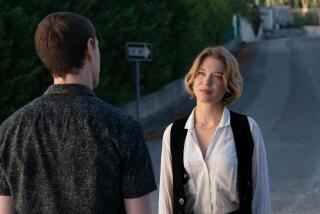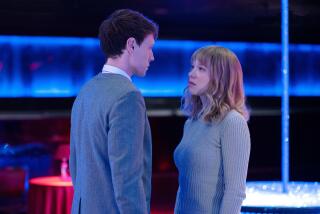Review: Angelina Jolie is wickedly good in the not-quite-classic ‘Maleficent’
In re-imagining the infamous evil queen who curses an innocent girl, “Maleficent” is very much a cautionary tale for modern times. It essentially begs the question — are you sure it was the shrew that needed taming?
It stars a wickedly good Angelina Jolie as the legendary Maleficent. In her hands, the queen is endlessly fascinating and worlds away from the fairy tale staple that so many generations have been introduced to via Disney’s animated “Sleeping Beauty” (1959). The new film’s position is clear and uncompromising on the question of who was in the wrong.
Unlike “Sleeping Beauty,” “Maleficent” explains all: motivation, regrets — from the queen’s point of view. This multifaceted Maleficent has wit and empathy as well as rage. Jolie hasn’t looked like she’s had such fun with a role since 2005’s “Mr. & Mrs. Smith,” though her “Kung Fu Panda” Tigress does have a bit of an ironic growl.
The other players in Maleficent’s sphere and the bones of the ancient story will feel familiar, based as it is on the animated movie and one of 17th century French writer Charles Perrault’s folk tales. But the spine of it has been changed by screenwriter Linda Woolverton. She joined the Disney fairy tale business with 1991’s animated hit “Beauty and the Beast” after a lot of work in episodic TV. Veteran art director Robert Stromberg directs.
Like most fairy tales, there are good and evil metaphors for little ones and grown-ups alike. In that regard, “Maleficent” is Disney’s most adventurous female empowerment parable yet as it explores how the age-old power struggle between men and women shapes the identity of both parties. Though it never plays like a polemic, the film has so much it wants to say the emotional power that might have made it a classic is undercut — that is the other power struggle going on in the film.
Despite the bumps, “Maleficent” is visually striking from its watercolor palette to its ethereal woodland creatures, the ones that rise from the earth have the kind of fearsome look and power that might frighten little ones. Stromberg’s mastery of the craft earned him art direction Oscars for his work on “Avatar” (2009) and “Alice in Wonderland” (2010), and you can feel the imprint of that artistry in every frame.
Along with a crack creative team that includes cinematographer Dean Semler, production designers Gary Freeman and Dylan Cole, costume designer Anna B. Sheppard and senior effects supervisor Carey Villegas, the filmmaker creates a world that sits on the edge of fantasy and reality. James Newton Howard’s score is a lovely accompaniment.
Though the film starts earlier, Maleficent’s primary beef is with Stefan (Sharlto Copley), who grows from a charming ordinary boy (Michael Higgins as the youngest, Jackson Bews as the teen) into a weak man desirous of being king.
Aurora is the infant Maleficent curses for her father’s crimes, and as a youngster she’s played by one of Jolie’s little ones, Vivienne Jolie-Pitt, followed by Eleanor Worthington-Cox. The luminous Elle Fanning steps in as Aurora at 16, pricking her finger on a spindle and falling in a death-like sleep while she awaits true love’s kiss. Oh, but so much happens before we get there.
We first meet Maleficent in simpler times. She is a fairy too, but one who looks like an ordinary girl (Ella Purnell) — with wings. No one rules her side of the world. It isn’t necessary. Her days are filled with magical creatures whose mischief is entertainment enough.
The bad times begin with King Henry (Kenneth Cranham), a power-hungry, land-grabbing monarch who first tries to conquer Maleficent and when that doesn’t work demands her head. Stefan uses his boyhood friendship to get to her. Though he doesn’t have the stomach for murder, what he does provides the film’s most chilling scene.
That Maleficent’s wings are clipped when she gets too powerful serves as a potent allegory for glass ceilings. The arc of Maleficent from innocent herself to evil queen is as much about survival as revenge. And the price exacted for getting to the top is a high one. It plays even more ironically in the wake of the recent firing of the New York Times’ first female editor, Jill Abramson, and the descriptions of her management style as, well, shrewish.
Much of the film revolves around the relationship between Maleficent and Aurora as the girl grows up. A trio of tiny fairies — Knotgrass (Imelda Staunton), Flittle (Lesley Manville) and Thistlewit (Juno Temple) — who buzz around offering opinions and stirring up nonsense with their magic are somehow charged with raising the girl. They do a job of delivering many of the film’s lighter notes.
This is Jolie’s film because of the Maleficent she makes. Everyone else, even Aurora, fades in her presence. When she is on the screen, she is all you really see. In addition to an uncanny resemblance to the animated queen — those legendary cheekbones enhanced to an even sharper edge, those horns — the actress creates a queen who may not be easy to love, but she is hard to hate. The black-and-white stereotypes are replaced by far more subtle shadings, the sneer that so characterized the original Disney queen is softened.
And we haven’t even gotten to the curse-breaking power of true love’s kiss. You will likely see this twist coming, but it’s a nice one anyway.
------------
‘Maleficent’
MPAA rating: PG for sequences of fantasy action and violence, including frightening images
Running time: 1 hour, 37 minutes
Playing: In general release
More to Read
Only good movies
Get the Indie Focus newsletter, Mark Olsen's weekly guide to the world of cinema.
You may occasionally receive promotional content from the Los Angeles Times.







